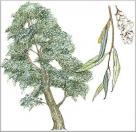White Willow - Salix alba
Medium-sized tree that loves damp soils and sunny positions, the White Willow is the most common riparian species of Italian fresh water habitats.
The lanceolate, pinnate-veined leaves, with short stalk and very pale lower page, enable the tree to be easily identified even from afar.
The flowers, unisexual and on dioecious plants (males and females), are arranged in erect catkins which grow before the leaves appear. The tiny seeds are covered with a fine floss.
Willows are fast growing trees, but they do not live long. Because they are so easy to propagate by cuttings, sets, layers and shoots they are particularly suitable for stabilising river banks in biological/natural engineering.
But this is only the most recent of the many uses man has made of this tree: grown as a pollard, the willow's pliant branches are used for basket work (wicker) and to bind vines; the tannin-rich bark has been used for tanning leather, whilst it has long been employed in popular medicine for its salicyn content, a febrifugal glycoside.
For some time now, acetylsalicylic acid has been extracted from salicyn, as it is the active ingredient of aspirin, today obtained synthetically. In local Italian dialects, willows are also called "salie" or "torchi" (presses), the last name refers to pollards).




